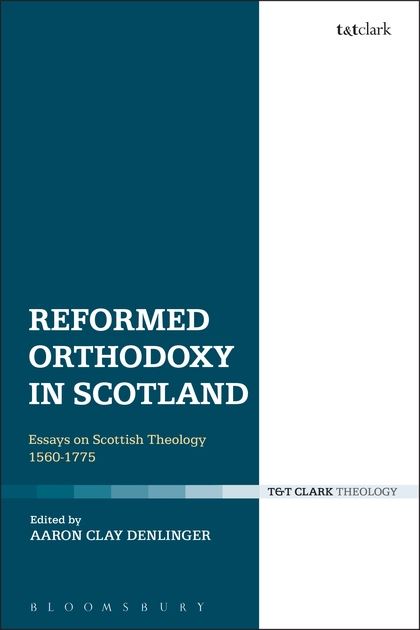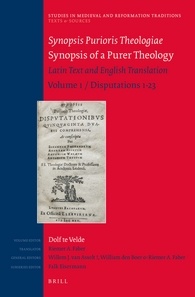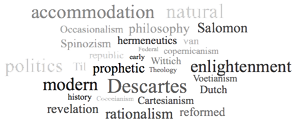[This is the first installment of a three-part book review. For the second part,
click here.]
Reformed Orthodoxy in Scotland: Essays on Scottish Theology 1560-1775, edited by Aaron Clay Denlinger. London/New York: Bloomsbury T&T Clark, 2015. 304 pages.
 The past three decades have seen a significant shift in historical scholarship regarding the assessment of Reformed Orthodoxy. While older accounts posit a sharp discontinuity between the outlook of the magisterial Reformers and their theological heirs, recent research suggests a more complex relationship involving both fundamental commonalities in terms of content and differences when it comes to theological method. Following this ‘revisionist’ approach, the present volume focuses on theological developments in post-Reformation Scotland. According to the overarching claim of this collection of essays “Scotland played a significant role in the development of Reformed Orthodoxy” as it harbored a theological life that was “vibrant and intimately connected to the wider European scene.” (2) Each of the fourteen essays included in this volume is meant to substantiate this claim in some way or another. As a cursory look at the table of contents suggests, the emphasis clearly lies on Early (c. 1560–c. 1640; six essays) and High Orthodoxy (c. 1640–c. 1690; five essays). Only three contributions deal with Late Orthodoxy (c. 1690 onwards). In what follows, I will briefly discuss each essay before I conclude this review with an overall assessment of this volume.
The past three decades have seen a significant shift in historical scholarship regarding the assessment of Reformed Orthodoxy. While older accounts posit a sharp discontinuity between the outlook of the magisterial Reformers and their theological heirs, recent research suggests a more complex relationship involving both fundamental commonalities in terms of content and differences when it comes to theological method. Following this ‘revisionist’ approach, the present volume focuses on theological developments in post-Reformation Scotland. According to the overarching claim of this collection of essays “Scotland played a significant role in the development of Reformed Orthodoxy” as it harbored a theological life that was “vibrant and intimately connected to the wider European scene.” (2) Each of the fourteen essays included in this volume is meant to substantiate this claim in some way or another. As a cursory look at the table of contents suggests, the emphasis clearly lies on Early (c. 1560–c. 1640; six essays) and High Orthodoxy (c. 1640–c. 1690; five essays). Only three contributions deal with Late Orthodoxy (c. 1690 onwards). In what follows, I will briefly discuss each essay before I conclude this review with an overall assessment of this volume.
The first essay by Donald MacLean (PhD, University of Wales; Research Supervisor at Wales Evangelical Divinity School, UK) deals with the Scottish Reformer John Knox and the reception of his doctrine of predestination by later orthodox theologians. MacLean disputes with two assertions propounded by older scholarship. First, he takes issue with the claim that Knox’s strict doctrine of double predestination as expounded in On Predestination (1560) stands in conflict with the more lenient statements in his other writings (‘Knox vs. Knox’). Second, MacLean challenges the assumption concerning a sharp discontinuity between Knox’s allegedly rigid predestinarianism and the ‘evangelical’ federal Calvinism of people like Rutherford, Gillespie, and Dickson (‘Knox vs. the Knoxians’). In General, MacLean’s case for “one John Knox” as well as for a “relative consistency of Knox’s doctrine of predestination with the teaching of the Scottish federalists” (24) is convincing. MacLean’s treatise evidences a wide familiarity with Knox’s writings and recent historiographical discussions. However, from a methodological point of view a critical remark concerning the comparison conducted in part two is in order. To establish a basic continuity between Knox and the Scottish federalists with respect to the doctrine of predestination, he compares their views on reprobation, the gospel offer, common grace, and God’s universal love. MacLean does not make the effort to justify his choice of media comparationis. Yet, it is far from self-evident and is even problematic in light of the fact that the ‘gospel offer’ and ‘common grace’ became well-defined and much debated concepts only in later centuries. Using these categories without careful reflection opens the door for anachronistic interpretation, i.e. reading Knox through the lens of later theological developments.
The second chapter written by Ernest R. Holloway III (PhD, University of Aberdeen; Adjunct Professor of Church History at Westminster Theological Seminary, USA) focuses on the Renaissance humanist Andrew Melville (1545–1622) and his role in the university reforms and particularly the establishment of Hebrew studies in post-Reformation Scotland. This essay begins with a historical sketch outlining the developments of Hebrew scholarship in early modern Scotland. Next, Holloway describes the phenomenon of ‘Christian Hebraism’ in the context of European Humanism. This provides him with the necessary background to depict and evaluate Melville’s own ‘Christian Hebraism’ in the final sections. According to Holloway, Melville’s achievements had a considerable impact on the development of Hebrew studies in his home country, but they could hardly compete with those of major Hebraists on the continent. Thus it seems, that the conclusion of this particular contribution runs somehow contrary to the overall thesis of the volume.
Chapter three comes from the pen of Brannon Ellis (PhD, University of Aberdeen) and consists in an analysis of the relationship between Christ and election in the thought of Robert Rollock (1555-1599). Ellis argues that Rollock’s position on this matter does not conform to “typical covenantal Reformed views” (e.g. Turretin). Instead of viewing Christ as the primary means by which the eternal decree is carried out (election through Christ), Rollock taught that “both as an eternal decision and according to its temporal execution, election occurs in the person of Christ” (49). In Rollock’s ‘Christological Supralapsarianism’, Ellis explains, the person of the divine-human Mediator logically precedes election, as well es any other aspect of the decree of God. Thus, Rollock’s position to a certain extent evades the criticism leveled at Reformed Orthodoxy by modern theologians like Barth, Torrance, McCormack etc.
Ellis’s piece is a well-informed and stimulating ‘minority report’ on an important dogmatic issue. It demonstrates once more that the old portrayal of Reformed Scholasticism as a monolithic movement has rightly been abandoned in recent years.
The forth chapter by Nicholas Thompson (PhD, University of Glasgow; lecturer in Church History at the University of Auckland, New Zealand) is devoted to a special emphasis of Aberdeen theologians in the first half of the seventeenth century, namely the engagement with Roman-Catholic polemics claiming universality and doctrinal continuity. Drawing on many primary sources Thompson sets out to show, how particular developments on a local level were connected to the international exchange among Reformed Orthodox theologians. Unfortunately, this contribution suffers from the lack of a clear structure which makes it difficult to follow the train of thoughts.
Aaron Denlinger (PhD, University of Aberdeen, Professor of Church History and Historical Theology at Reformation Bible College in Sanford, USA), the author of chapter five tackles a topic that has received much attention in very recent years: hypothetical universalism. He does so by focusing on the soteriology of Robert Baron (c. 1596-1639), a Scotsman whose views have variously been described both as ‘quasi-Arminian’ and ‘moderate Calvinist’. In his unpublished and incomplete work Septenarius sacer de principiis et causis fidei catholicae, Baron deals with two major questions related to the concept of hypothetical universalism, namely, if there is a universal will in God to save each and every man, and whether Christ’s work was intended by God for all men without exception. As Denlinger shows, Baron tries to steer a middle course on either of these questions rejecting both the Arminian position and the more strict particularism of most of his Reformed colleagues. Having outlined Baron’s hypothetical universalism, Denlinger concludes his chapter with worthwhile methodological reflections concerning the use of such umbrella terms like ‘Calvinist’ and ‘Arminian’. Instead of using these problematic descriptors, he suggests to employ the terms ‘Orthodoxy’ / ‘orthodox’ in order to classify views like that of Baron. Since Denlinger defines ‘orthodox’ simply as ‘in line with the Reformed Confessions’, one wonders if the term “Reformed” would not be an even better alternative.
Chapter six by Donald Macleod (DD, Westminster Theological Seminary; Emeritus Professor of Systematic Theology at the Free Church College in Edinburgh, UK) concludes the first part of the book on Early Reformed Orthodoxy. By examining the life and work of Alexander Henderson (c. 1583–1646), Macleod sets out to show that “the thought and labours of Scottish Reformed orthodoxy were not confined to the pulpit and the classroom.” (119) What emerges is a vivid portrait of an ecclesiastical statesman who – despite his meager literary legacy – had a decisive formative impact on the shape of the Scottish kirk. When, Macleod occasionally contrasts Anderson’s ecclesiastico-political vision with the modern separation of church and state, the reader can only guess that these brief comparisons are meant as a critique of present-day secularism.
[This is the first part of a three-part series. Next week I will post the second part of this review dealing with section two on
High Orthodoxy.]
This book presents a new critical Latin edition and an English translation of Johannes Maccovius’ (1588–1644) seminal and fascinating work on theological and philosophical distinctions. Considered one of the sharpest theological minds of his time, Maccovius played an important role in ongoing debates on seventeenth-century theology, particularly in terms of his contribution to logic and metaphysics.


 This bilingual edition of the Synopsis Purioris Theologiae (1625) makes available for the first time to English readers a seminal treatise of Reformed Scholasticism. Composed by four professors of Leiden University (Johannes Polyander, Andreas Rivetus, Antonius Walaeus, and Anthonius Thysius), it gives an exhaustive yet concise presentation of Reformed theology as it was conceived in the first decades of the seventeenth century. From a decidedly Reformed perspective, the Christian doctrine is defined in contrast with alternative or opposite views (Catholic, Spiritualist, Arminian, Socinian). Both on the academic level and on the ecclesiastical level, the Synopsis responds to challenges coming from the immediate context of the early seventeenth century. The disputations of this first volume cover topics such as Scripture, doctrine of God, Trinity, creation, sin, Law and Gospel.
This bilingual edition of the Synopsis Purioris Theologiae (1625) makes available for the first time to English readers a seminal treatise of Reformed Scholasticism. Composed by four professors of Leiden University (Johannes Polyander, Andreas Rivetus, Antonius Walaeus, and Anthonius Thysius), it gives an exhaustive yet concise presentation of Reformed theology as it was conceived in the first decades of the seventeenth century. From a decidedly Reformed perspective, the Christian doctrine is defined in contrast with alternative or opposite views (Catholic, Spiritualist, Arminian, Socinian). Both on the academic level and on the ecclesiastical level, the Synopsis responds to challenges coming from the immediate context of the early seventeenth century. The disputations of this first volume cover topics such as Scripture, doctrine of God, Trinity, creation, sin, Law and Gospel.